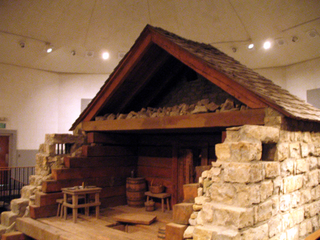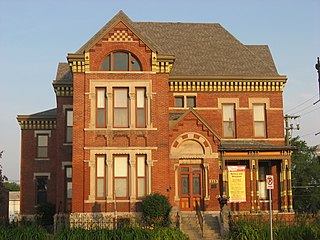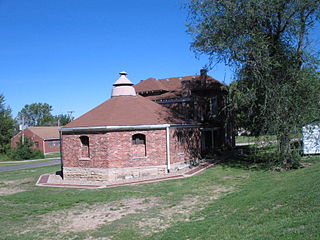
Council Bluffs is a city in and the county seat of Pottawattamie County, Iowa, United States. Its population was 62,799 as of the 2020 census, making it the state's tenth most populous city, and the most populous city in Southwest Iowa. The Omaha metropolitan region of which Council Bluffs is a part, is the 58th largest in the United States, with an estimated population of 967,604 (2020). It is located on the east bank of the Missouri River, across from Omaha, Nebraska. Until about 1853 Council Bluffs was known as Kanesville. Kanesville was the historic starting point of the Mormon Trail. Kanesville is also the northernmost anchor town of the other emigrant trails because there was a steam-powered boat which ferried the settlers' wagons and cattle across the Missouri River. In 1869, the first transcontinental railroad to California was connected to the existing U.S. rail network at Council Bluffs.

Daviess County is a county located in the U.S. state of Missouri. As of the 2020 census, the population was 8,430. Its county seat is Gallatin. The county was organized December 29, 1836, from Ray County and named for Major Joseph Hamilton Daveiss, a soldier from Kentucky who was killed in 1811 at the Battle of Tippecanoe.

Pottawattamie County is a county located in the U.S. state of Iowa. At the 2020 census, the population was 93,667, making it the tenth-most populous county in Iowa. The county takes its name from the Potawatomi Native American tribe. The county seat is Council Bluffs.

Crawfordsville is a city in Montgomery County in west central Indiana, United States, 49 miles (79 km) west by northwest of Indianapolis. As of the 2020 census, the city had a population of 16,306. The city is the county seat of Montgomery County, the only chartered city and the largest populated place in the county. It is the principal city of the Crawfordsville, IN Micropolitan Statistical Area, which encompasses all of Montgomery County. The city is also part of the Indianapolis–Carmel–Muncie, IN Combined Statistical Area.

Gallatin is a city in Daviess County, Missouri, United States. The population was 1,821 at the 2020 census. It is the county seat of Daviess County.

Liberty Jail is a historical jail in Liberty, Missouri, United States, which served as the county jail of Clay County, Missouri between December 1834 and 1853. The jail is known in The Church of Jesus Christ of Latter-day Saints due to the imprisonment of Church president Joseph Smith and some of his associates during the 1838 Mormon War.
The Reno Gang, also known as the Reno Brothers Gang and The Jackson Thieves, were a group of criminals that operated in the Midwestern United States during and just after the American Civil War. Though short-lived, the gang carried out the first three peacetime train robberies in U.S. history. Most of the stolen money was never recovered.

The Porter County Museum is a museum that is located at 20 Indiana Avenue, Valparaiso, Indiana.

The Henry County Sheriff's Residence and Jail is a government building in Napoleon, Ohio, United States. Built in 1882 to a design by architect D.W. Gibbs, the residence-and-jail is located adjacent to the Henry County Courthouse in the city's downtown.

The Jackson County's 1859 Jail Museum in Independence, Missouri, United States was constructed in 1859 as a county jail for Jackson County, Missouri. It was decommissioned and replaced in 1933. It has been restored as a public museum. It was listed on the National Register of Historic Places in 1970.

The Pottawattamie County Jail, also known as 'Squirrel Cage Jail' in Council Bluffs, Iowa, United States was built in 1885 and it was listed on the National Register of Historic Places in 1972. The building is one of three extant “squirrel cage jails,” also known as rotary jails. It was designated a National Historic Landmark in 2023.

The Sandusky County Jail and Sheriff's House is a historic government building near downtown Fremont, Ohio, United States. Built in the early 1890s, it was used as an incarceration facility for almost a century before closing and being converted into an office building.

The Appanoose County Sheriff's House and Jail is a historic structure located in Centerville, Iowa, United States. Provisions for a jail in Appanoose County were not realized until 1855 when a small stone building was constructed. It was used for about ten years when one of the inmates easily escaped.

The Franklin County Sheriff's Residence and Jail is a historic building located in Hampton, Iowa, United States. The combination sheriff's residence and jail was the most common type of detention facility built by Iowa counties from the 1840s to around 1950. In this facility in Hampton the sheriff's residence was the two-story Italianate style structure closest to the street. There was a cell on the second floor used for female or juvenile prisoners. The sheriff's wife generally provided the meals and laundry services for the prisoners from the residence. The small cell block for men and a women's holding cell was in the single-story wing off of the back of the house. The building was constructed by local attorney D.W. Dow, and P.J. Pauly & Bro. of St. Louis provided the cells. It was completed in 1880. The sheriff continued to reside here into the 1960s, and the building was used for a jail until 1988. It was individually listed on the National Register of Historic Places in 1996. In 2003 it was included as a contributing property in the Hampton Double Square Historic District.

Montgomery County Jail and Sheriff's Residence is a historic jail and sheriff's residence located at Crawfordsville, Montgomery County, Indiana. It was built in 1882 in two sections, and is a 2+1⁄2-story, red brick and limestone building in a combination of Italianate, Gothic Revival, and Romanesque Revival style architecture. The jail is a rotary jail; it is the only example of this type in Indiana and one of two left in the United States. The building houses a local history and prison museum.

Crawfordsville Commercial Historic District is a national historic district located at Crawfordsville, Montgomery County, Indiana. The district encompasses 105 contributing buildings, 1 contributing structure, and 1 contributing object in the central business district of Crawfordsville. It developed between about 1836 and 1940, and includes notable examples of Italianate, Classical Revival, and Bungalow/American Craftsman style architecture. Located in the district are the separately listed Montgomery County Jail and Sheriff's Residence and Otto Schlemmer Building. Other notable buildings are the Montgomery County Courthouse (1876), Ben Hur Life Building (1911), Hanna-Graham Building, Elston Bank Building (1869), Masonic Temple (1902), Carnegie Library (1902), Commerce Building (1907), Municipal Building (1933), Indiana National Guard Armory (1939), and U.S. Post Office (1940).

In the United States, a one-room jail is a type of jail with only one room, or cell.

Daviess County Rotary Jail and Sheriff's Residence is a historic rotary jail and sheriffs residence located in Gallatin, Daviess County, Missouri. It was built in 1888 by the Pauly Jail Building and Manufacturing Company of St. Louis, Missouri. The jail is a one-story, octagonally-shaped brick structure on a stone foundation. The sheriff's residence is a two-story, T-shaped brick dwelling. It is connected to the jail by a two-story, irregularly-shaped structure which houses the jail's kitchen at the first floor level and the women's cells at the second-story level.


















